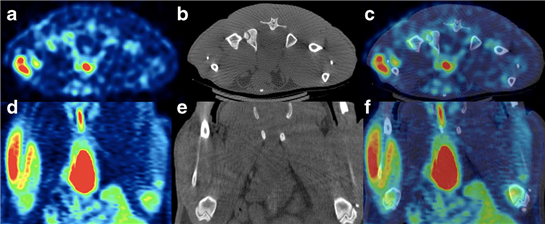글로벌 연구동향
핵의학
- 2016년 11월호
[Mol Imaging Biol.] Longitudinal Changes in Glucose Metabolism of Denervated Muscle after Complete Peripheral Nerve Injury.부산대병원/ 박경준, 김인주*
- 출처
- Mol Imaging Biol.
- 등재일
- 2016 Oct
- 저널이슈번호
- 18(5):741-7. doi: 10.1007/s11307-016-0948-7
- 내용

그림. 우측 좌골신경의 절단 1주일 후 하지근육의 FDG 섭취 증가를 확인하였습니다.Abstract
PURPOSE:
Electrodiagnostic studies can obtain information 2 or 3 weeks after an acute nerve injury. Previous studies have shown increased glucose metabolism in denervated muscles 1 week after injury using 2-deoxy-2-[(18)F]fluoro-D-glucose ([(18)F]FDG) positron emission tomography (PET). Therefore, this study aimed to evaluate the changes in glucose metabolism in denervated muscles using serial monitoring by [(18)F]FDG PET scans.
PROCEDURES:
Denervation was induced in eight male Sprague-Dawley rats (aged 7 weeks old) weighing 200-250 g. The right legs of the rats were denervated by resecting the sciatic nerve in the thigh after the initial skin incision. Two rats were sacrificed 1 and 10 weeks after denervation. Skeletal muscles (gastrocnemius and tibialis anterior) were excised from both the right and left legs of the rats. Staining with hematoxylin and eosin, glucose transporter (GLUT)-1, GLUT-4, and hexokinase II was undertaken. PET/computed tomography (CT) scans were performed on the six remaining rats a total of five times at 1, 2, 5, 8, and 10 weeks after denervation. Regions of interest were drawn on integrated PET/CT images to measure the degree of [(18)F]FDG uptake in the right and left lower leg muscles. Target-to-background ratios (TBRs) were calculated by dividing the FDG uptake of the lower leg muscles by that of the upper leg muscles.
RESULTS:
The TBRs of the denervated muscles were higher than those of the control muscles at both 1 (6.84 ± 1.98 vs. 1.18 ± 0.11, p = 0.009) and 2 (4.10 ± 2.05 vs. 1.86 ± 0.73, p = 0.0374) weeks after denervation. After 5 (2.18 ± 0.78 vs. 1.35 ± 0.47, p = 0.1489), 8 (1.76 ± 0.18 vs. 1.69 ± 0.18, p = 0.5127), and 10 (1.76 ± 0.52 vs. 1.56 ± 0.37, p = 0.5637) weeks, the difference in the TBRs between the denervated and controls became non-significant.
CONCLUSIONS:
[(18)F]FDG PET can visualize increased glucose metabolism in a denervated muscle early as 1 week after injury. Therefore, PET could be adopted as a noninvasive imaging modality for acute nerve injuries. In addition, [(18)F]FDG PET may help to understand the role of the nervous system in the control of peripheral tissues.
Author information
Pak K1, Shin MJ2, Hwang SJ3, Shin JH4, Shin HK5, Kim SJ1, Kim IJ6.
1Department of Nuclear Medicine and Biomedical Research Institute, Pusan National University Hospital, Busan, South Korea.
2Department of Rehabilitation Medicine and Biomedical Research Institute, Pusan National University Hospital, Busan, South Korea.
3Center for Anti-Aging Industry, Busan, South Korea.
4Department of Neurology and Research Institute for Convergence of Biomedical Science and Technology, Pusan National University Yangsan Hospital, Yangsan, South Korea.
5Division of Meridian and Structural Medicine, School of Korean Medicine and Korean Medical Science Research Center for Healthy Aging, Pusan National University, Yangsan, South Korea.
6Department of Nuclear Medicine and Biomedical Research Institute, Pusan National University Hospital, Busan, South Korea. pnuhnm@gmail.com.
- 키워드
- 2-deoxy-2-[18F]fluoro-D-glucose; Denervation; Positron emission tomography
- 연구소개
- 동물모델을 이용하여 신경절단시 해당 근육의 당대사가 증가함을 확인한 연구로서, 신경절단 후 2주 후까지, F18-FDG PET로 확인된 근육의 당대사의 변화를 확인하였습니다. 이를 통해, 신경손상시 진단도구로서의 F18-FDG PET의 가치를 확인해보았습니다.
- 덧글달기








편집위원
FDG PET은 주로 종양 뇌 혹은 심장 평가에 사용되었고, 염증평가에 추가적으로 이용된다. 이 연구는 근육 당대사 평가에 FDG PET을 이용한 새로운 연구방식으로 임상핵의학자에게 관심을 많이 끌수 있을 것이다.
덧글달기닫기2016-11-03 16:02:46
등록